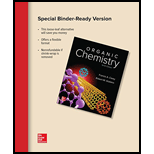
Concept explainers
Interpretation:
It is to be determined if the shown
Concept introduction:
The position of the carbon signal in
Presence of an electronegative (electron rich) atom or group on a carbon deshields it, moving its signal downfield.
Want to see the full answer?
Check out a sample textbook solution
Chapter 22 Solutions
Loose Leaf for Organic Chemistry
- After the reduction of camphor with NaBH4 experiment, you took a 1H-NMR of your product sample. The sample ave the following 1H-NMR singlas with the given integrations (2.314 and 9.497). Determine the product ratio of isoboreneol to borneol in this particular mixture.arrow_forwardWhat is the most likely organic product of the exhaustive hydrolysis of PhCN? A. benzoic acid B. benzamide C. benzylamine D. benzenearrow_forwardThe 1H NMR spectrum of N,N-dimethylformamide shows three singlets at2.9, 3.0, and 8.0 ppm. Explain why the two CH3 groups are not equivalentto each other, thus giving rise to two NMR signals.arrow_forward
- Grinard Reaction with Aldehyde: (a) What peaks in the NMR spectrum most clearly demonstrate the presence of the predicted product ,1-(4-methoxypenyl)-methylpropan-1-ol? (b) If the product had unreacted aldehyde remaining, what NMR peak would indicate the presence of this contaminant?arrow_forwardThe 1H NMR spectrum of N,N-dimethylformamide shows three singlets at 2.9, 3.0, and 8.0 ppm. Explain why the two CH3 groups are not equivalent to each other, thus giving rise to two NMR signals.arrow_forwardA chemist records an ESI accurate mass spectrum of an intermediate during a synthesis. The desired compound is C29H31N3O8S. She sees a peak(M+H)^(+) on her ESI-TOF LCMS at 583.1733. The two possibilites for the incorrect feature are A: incoporation of a deuterium at an acidic site from the CDCL3 used for NMR she ran immedately prior LC-MS or B: An amide was hydrolyzed to an acid. Assuming the mass spectrometer is well calibrated, which of these two options is supported by the data. Be sure to explain your answer.arrow_forward
- 1. Arrange the following compounds in decreasing order of reactivity towards NaI in acetone: I. Methyl bromide II. Isopropyl bromide III. Ethyl bromide IV. t-butyl bromide 2. Rank the following compounds in order of increasing basicity: I. p-nitroaniline III. N-methylaniline II. p-aminobenzaldehyde IV. p-methylaniline 3. Order the following acids with respect to increasing acidity: I. Fluoroacetic acid III. Chloroacetic acid II. 3-chloropropanoic acid IV. Propanoic acid 4. Arrange the ff. in their decreasing order (easiest first) of relative ease in the acid-catalyzed esterification of ethyl alcohol: I. (CH3)2CHCOOH II. CH3CH2COOH III. (CH3)3COOHarrow_forward5. (How many NMR signals would Alder reaction product from the reaction of (bp 36C) and maleic anhydride in tetrhydrofuran (bp54C)? In other words how many different types of protons are in the exo-7-oxabicyclo (2.2.1)hept-5-ene-2,3-dicarboxylic.arrow_forwardSketch an H-NMR spectra of the final product, p-nitroacetanilide.arrow_forward
- The 1H NMR spectra for two esters with molecular formula C8H8O2 are shown next. Which of the esters is hydrolyzed more rapidly in an aqueous solution with a pH of 10?arrow_forwardHow does the 13C NMR resonance of the thiol/thione carbon compare between the free HOPTO ligand and the complexed ligand in Pd(mpo)2? Propose a reason for the difference and why this resonance is shifted more than the others.arrow_forward3 The 1H- and 13C-NMR data of an ester of molecular formula C6H10O2 are given below. Also shown are the COSY and HETCOR NMR spectra of the ester. Identify the ester, explaining how you reach your conclusion. 1H-NMR: 7.20-6.90 (1H), 5.85 (1H), 4.16 (2H), 1.88 (3H), 1.31 (3H) ppm 13C-NMR: 166.7, 144.5, 123.0 , 60.2, 18.0, 14.3 ppmarrow_forward
 Organic ChemistryChemistryISBN:9781305580350Author:William H. Brown, Brent L. Iverson, Eric Anslyn, Christopher S. FootePublisher:Cengage Learning
Organic ChemistryChemistryISBN:9781305580350Author:William H. Brown, Brent L. Iverson, Eric Anslyn, Christopher S. FootePublisher:Cengage Learning Macroscale and Microscale Organic ExperimentsChemistryISBN:9781305577190Author:Kenneth L. Williamson, Katherine M. MastersPublisher:Brooks Cole
Macroscale and Microscale Organic ExperimentsChemistryISBN:9781305577190Author:Kenneth L. Williamson, Katherine M. MastersPublisher:Brooks Cole

